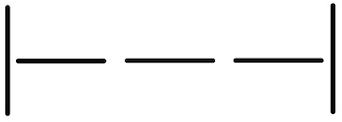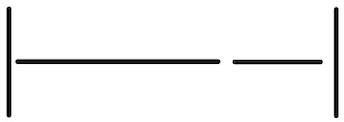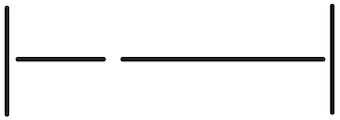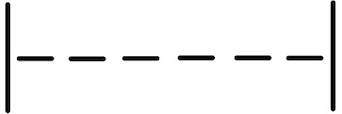Compound Meter
Beats in compound meter have three equal divisions. Traditional notation of compound meter always uses a dotted note to represent the beat. This is a little more to keep track of than simple meter’s two divisions, but it can be helpful to think of the three parts of each beat as its “beginning,” “middle,” and “end.”
In any meter, we can of course get notes that last longer than a beat. We can typically track these simply by counting the number of beats they occupy. Since compound beats are represented by dotted notes, it’s not always as intuitive to figure out what note value to use to notate a long note in compound meter as it is in simple meter. Sometimes, compound meter requires some awkward notation: for example, a three-beat note value is typically represented by a larger dotted note tied to a smaller one (for example, a dotted half tied to a dotted quarter in nine-eight meter).
Note the difference between the long-short rhythmic cell on this page (C3) and the long-short rhythmic cell in simple meter (S5). In cell C3, the length ratio of the long note to the short note is 2:1, while in cell S5, the ratio is 3:1. These can sound very similar! At slower tempos, you may be able to tell the difference by subdividing. Some people consider the simple meter long-short more “snappy” or “march-like” and the compound meter long-short more “lilting” or “rocking.” Finally, you can always try getting up and skipping along to the rhythm: it should generally be possible to skip (or imagine skipping) along to a compound long-short and much less natural to do so along with the simple meter version.
The table below shows some of the most common beat-length patterns in compound meter. Any of the notes in the cells below may be replaced by rests. When this occurs, we simply need to experience the rest as a (silent) part of the pattern.
| Reference number: | C1 | C2 | C3 | C4 | C5 |
|---|---|---|---|---|---|
| Description: | one note per beat | three even notes per beat | long-short within a compound beat | short-long within a compound beat | six even notes per beat |
| Staff notation (dotted eighth note beat): | |||||
| Staff notation (dotted quarter note beat): | |||||
| Staff notation (dotted half note beat): | |||||
| Takadimi syllables: | ta | ta ki da | ta da | ta ki | ta va ki di da ma |
| Number syllables: | 1 | 1 la li or 1 & a | 1 li or 1 a | 1 la or 1 & | 1 ta la ta li ta |
| Kodaly syllables: | |||||
| Protonotation |  |
 |
 |
 |
 |
Activity: Improvise and identify rhythms
Goal: Generate or identify the defined rhythmic cells.
Before you start: This activity works best with at least one other person. But you can also do it on your own; just skip step 3.
Instructions:
- Identify one person to improvise.
- The improviser comes up with and performs a short rhythm (perhaps 4–6 beats long) made up entirely of the rhythmic cells defined above, plus optionally notes longer than a beat.
- The other student(s) identifies/identify which cells were used and in what order.
If this activity feels too easy, go ahead and add pitches at an appropriate difficulty level to the improvised rhythm.
Activity: Read rhythmic cells
Goal: Notice when rhythmic cells occur in notated music.
Before you start: You’ll need a source of notated melodies or rhythms that primarily use the rhythmic cells listed above. Sight-reading anthologies are a good source; many have chapters dedicated to foundational rhythms within compound meter. You can do this activity vocally or on another instrument.
Instructions:
- Look over the notation, note the meter, and set up an appropriate sense of meter internally.
- Scan over the notation, identifying rhythmic cells. Note that some notes in the rhythmic cells may be replaced by rests; you can still call up the “sense” of the rhythmic cell, simply experiencing the silence as part of the pattern.
- Perform the rhythm, with or without pitch.
Activity: Find rhythmic cells “in the wild”
Goal: Develop sensitivity to rhythmic patterns as they occur in music.
Instructions:
- Listen to a song from the playlist below and determine its meter.
- Listen to the first 1–2 phrases of the song and identify the rhythmic cells used and their order.
- Optionally, identify an appropriate meter, time signature, and durational symbols that represent the music.
Activity: “Point and Perform” in a Group
Goal: Perform indicated rhythmic cells
Before you start: This is a group activity.
Instructions:
- Identify a leader. This person will display the defined rhythmic cells in a way that everyone else can see, such as in notation or protonotation on a board.
- The leader sets up a steady beat, perhaps by conducting, and everyone else aligns themselves with that beat.
- Once everyone is ready, the leader points at rhythmic cells, and the other participants perform them on rhythmic solfège, on “ta,” or by clapping or tapping. The leader should start by changing slowly, allowing the other participants to settle into each cell by performing it a few times in a row; as people get more comfortable, the pace of change can speed up until you are changing every beat.
Activity: Improvise rhythmic cells while listening to music
Goal: Use defined rhythmic cells to improvise to a piece of music.
Instructions:
- Start one of the songs in the playlist below.
- Pick a rhythmic cell listed above and perform it to the beat of the song playing
- As you perform the rhythmic cell, listen for where significant changes seem to happen in the music. At these points, change to a new rhythmic cell! If you feel like you aren’t able to hear these points of change while performing the rhythm, that’s ok (we’ll work on listening for form later)—just change when it feels appropriate to you.
- Continue to switch patterns until you feel comfortable with each of the four cells.
- If you feel pretty comfortable with the rhythmic cells, you might start performing them one after another or even jumping between them randomly instead of repeating one over and over.
Image Attributions |
|

